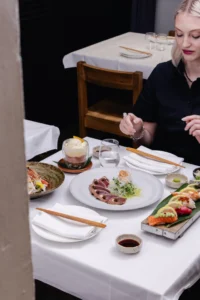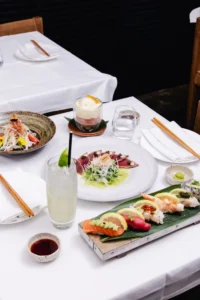Japanese Food Customs: The Ritual of Eating
Dining in Japan is more than just enjoying delicious food – it’s a deep ritual rooted in Japanese food customs. It is a deeply cultural ritual, filled with meaning and tradition. Japanese table manners reflect a strong sense of respect – for the food, for others, and for the act of eating itself. These traditions have evolved over centuries, shaping a dining experience that values harmony, mindfulness, and gratitude.
The Cultural Importance of Respect in Japan
A Culture Rooted in Harmony
 In Japan, every social interaction is guided by the principle of wa – harmony. This concept extends to the dining table. People do not rush meals. Instead, they share them with awareness and appreciation. They show respect to people, tools, ingredients, and customs that make the meal possible.
In Japan, every social interaction is guided by the principle of wa – harmony. This concept extends to the dining table. People do not rush meals. Instead, they share them with awareness and appreciation. They show respect to people, tools, ingredients, and customs that make the meal possible.
Gratitude as a Social Norm
Saying “Itadakimasu” before eating is a common Japanese custom. But it’s not simply a polite phrase. It expresses gratitude to everyone involved in the preparation of the meal – from farmers and fishers to chefs and hosts. After eating, diners say “Gochisousama deshita,” a way to thank the cook and acknowledge the meal as a shared experience.
Key Japanese Table Manners and Their Meanings
Chopsticks: More Than Just Tools
Chopstick etiquette in Japan is very specific. Never stick chopsticks upright in rice – this resembles a funeral rite. Don’t point, pass food from chopsticks to chopsticks, or hover indecisively over dishes. Each of these actions is seen as disrespectful. Always use the opposite end of your chopsticks to take food from shared plates. These small habits show care and mindfulness.
Silence Can Be Polite
Unlike in Western cultures, silence at the table is not rude in Japan. In fact, it can show respect for the food. Loud talking or laughing during meals might seem impolite, especially in formal settings. On the other hand, slurping noodles is perfectly acceptable – and even encouraged. It signals enjoyment and appreciation of the meal.
Handling Shared Dishes
When eating in a group, serving others before serving yourself is a sign of good manners. This act highlights the group-first nature of Japanese society. If a communal dish is shared, use the serving utensils or flip your chopsticks to avoid direct contact. This gesture keeps things hygienic and thoughtful.
Cleanliness: A Sign of Respect
Presentation Is Everything
Japanese meals are not only tasty – they look beautiful. Hosts often serve dishes in individual bowls and plates. They carefully arrange each item to show colour, season, and balance. This attention to detail invites the diner to appreciate the food visually before eating.
Don’t Waste Food
People consider leaving food behind impolite. It suggests you didn’t value what the host served. Try to eat everything on your plate as a sign of respect. Even a single grain of rice is treated with care.
Tidy Eating Habits
Japanese culture is full of beautiful words that express feelings we often struggle to say. Keeping your space clean during and after meals is important. Use the napkin provided, place your chopsticks back on the holder, and neatly fold your napkin if one is used. If eating at someone’s home, offering to clear the table is a thoughtful gesture.
Dining Etiquette in Social Settings: Japanese Food Customs
Pouring Drinks for Others
 When drinking in a group, it’s polite to pour for others rather than yourself. In return, others will pour your drink. This small act strengthens social bonds. Always watch your neighbour’s glass and refill when needed.
When drinking in a group, it’s polite to pour for others rather than yourself. In return, others will pour your drink. This small act strengthens social bonds. Always watch your neighbour’s glass and refill when needed.
Waiting for the Right Moment
In formal settings, wait for the host to say “Itadakimasu” before eating. Likewise, don’t start drinking until someone offers a toast. These traditions maintain a sense of unity and mutual respect.
Giving Compliments
Praising the food is a way to show appreciation. Simple phrases like “Oishii” (delicious) or “Totemo umai” (very tasty) are welcome. However, don’t overdo it. Genuine, modest compliments feel most respectful.
Respect Beyond the Table
Learning the Rules
Understanding Japanese table manners shows interest in the culture. It builds trust and goodwill, especially if you’re a visitor. Locals appreciate when foreigners try to follow their customs, even if they’re not perfect.
Passing It On
When dining with children, Japanese parents teach them these customs early. This ensures the traditions stay alive. Teaching respect at the table builds a foundation for polite behaviour in other parts of life.
Why These Manners Still Matter Today: Japanese Food Customs
A Blend of Old and New
Even in modern cities like Tokyo, traditional table manners are still followed. From family dinners to high-end restaurants, these customs remain relevant. They create an environment where everyone feels valued.
A Way to Slow Down
In today’s busy world, Japanese dining habits remind us to slow down and savour each bite. They encourage presence, connection, and gratitude – things we often forget in fast-paced daily life.
Building Stronger Bonds
Sharing a meal in Japan is about more than food. It’s about honouring relationships. By following these simple but powerful customs, you show care not just for yourself, but for those around you.
In Summary
Japanese table manners are a beautiful reflection of the country’s deep-rooted values. They teach us to respect the act of eating, those we share meals with, and the world that provides our food. Whether you’re visiting Japan or dining at a local sushi bar, following these customs can enrich your experience and show true appreciation for the culture.



